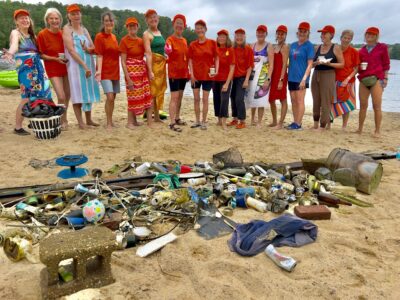In the fight against climate change, trees are among the fiercest soldiers. According to the U.S. Department of Agriculture, one mature tree can absorb more than 48 pounds of carbon dioxide (CO2) per year. That carbon is then permanently stored in the tree’s fibers until fires or decomposition release it back into the atmosphere.
Because trees are so effective at absorbing CO2, cutting them down can have a major negative impact on the environment — and that’s been happening a lot in recent decades. About 420 million hectares of forest were lost globally between 1990 and 2020, according to a report from the London School of Economics and Political Science that cited UN data.
Photo Courtesy USDA Forest Service
Numerous organizations worldwide are committed to curbing deforestation and planting more trees, but those aren’t the only ways to harness the environmental value of trees. Another way is to track the carbon inside them. That’s the mission at CTrees, a nonprofit that aims “to track carbon in every tree on the planet” and deliver science-based data designed to enable natural climate solutions.
CTrees uses artificial intelligence (AI) to analyze satellite, aerial, and local data from inventories of trees, “Fast Company” reported. The system is based on two decades of science. According to Sassan Saatchi, a senior scientist at NASA’s Jet Propulsion Laboratory who also serves as co-founder and CEO of CTrees, it works so well that it comes “close to the accuracy of the gold standard” of on-the-ground measurement.
On its website, CTrees describes itself as a team of “scientists and engineers with over 20 years of experience in building global carbon monitoring systems and solutions that have informed climate change policies.”
The organization’s experts work alongside public- and private-sector partners to provide operational data to governments, project developers, investors, and decision-makers.
Photo Courtesy CTrees
In addition to Saatchi, other CTree co-founders include:
- Phil Decola, co-chair of WMO Integrated Global GHG Information System
- Martin Brandt, professor of geography at the University of Copenhagen
- Philippe Ciais, research director at Institut Pierre-Simon Laplace in Guyancourt, France
- Jean-Pierre Wigneron, head of the INRAE Remote Sensing Lab in Bordeaux, France
Among CTrees’ recent launches is the Land Use Change Alert (LUCA), which was unveiled in September. A press release described LUCA as “the world’s first global radar-based forest disturbance alert system.”
It leverages data from the European Space Agency’s Sentinel 1 radar satellite system to fill a “critical gap in global forest monitoring” by providing near-real-time information on forests worldwide, the press release said.
As “Fast Company” reported, firms such as Pachama, a San Francisco-based start-up, also use AI tech and remote sensing to monitor forest changes for “specific carbon offset projects.”
The difference with CTrees is that it has a more global outlook. Its data will be especially important in countries that depend on trees to capture specific amounts of CO2 to meet Paris Climate Agreement goals. In addition, companies and nonprofits that sell carbon credits can use CTrees’ data to ensure their readings are accurate.
Photo Courtesy Pachama
“They need to have reliable datasets to monitor the forest, and they need to have high accuracy,” Saatchi told “Fast Company.” “Even groups that are working with Indigenous communities or with small farmers on reforestation and carbon credits can actually use the data,” he said. “At the same time, we will always add up the efforts of everyone to see exactly how we’re doing globally.”





